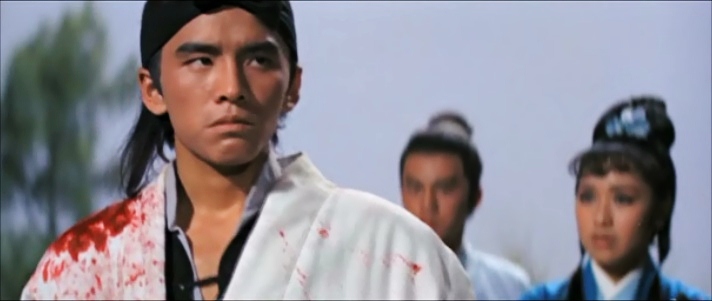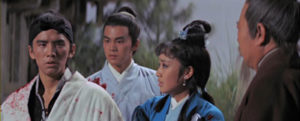
08 Aug A brief look at the fight choreography in Have Sword, Will Travel By Kim August
Shaw Brothers’ master choreographer Tang Chia (Tong Gai) teamed up with Yuen Cheung-Yan to create the various fight styles on display in this early Chang Cheh wuxia.
The aerial leaps and jumps aided by trampoline and light wirework are provided by David Chiang, a former stuntman apprentice of Tong, along with acrobatic newcomer Wang Chung. This early record of the action director’s fondness for flying swordsman appears most prominently in David’s lithe, noble teen gallant Yi Lo. The young man possesses an almost Peter Pan-like quality as he clears thickets, buildings and enemies alike. To set the mood, the high jumps and slow motion mid-air moves from Yi Lo, and Wang Chung’s nefarious Ghost Shadow are immediately on display in the entertaining credit sequence. To wit, this pixie-like flying (and killing) in the air with the greatest of ease would reappear years later to introduce David Chiang in Sun Chung’s martial legal opus, Judgement of An Assassin.
The almost playful nature of the trampoline aided brawls soon turn more dire as these flow into grounded swordplay and operatic duels performed by Chiang, Li Ching, Ti Lung, Chen Sing and Ku Feng. The melees include double hook swords, staff, and spears, thus showcasing the variety of martial weapons Tong Gai would deploy over his long career at the studio. In fact, Have Sword, Will Travel is amongst the choreographer’s earliest movies in which he builds a fighting style around a character.
For examples of this, look at Yi Lo and Ghost Shadow. Their high-flying skills reveal there is something exceptionally unique about their martial abilities and in their personalities. Ghost Shadow’s silent attacks make for an unpredictable adversary, while Yi Lo takes his body lifting skills for granted as his modesty veils how talented a fighter our lead character can be. Another example of this character-trait echoed in the kung fu style is seen in Ti Lung’s Brother Siang: his moves are as blunt and direct as the stoic swordsman. Siang’s preference rings loud and clear in dialog regarding mastery of the sword. To Siang, the use of hidden weapons (flying darts) is “a trifle skill,” but the “sword is the real challenge.”
Through this intriguing mix of land and air, Tong Gai and Yuen Cheung-Yan push their cast and crew into a dangerous world where weapons knowledge could save your life. Sifu Tong deployed many elements of his operatic training to inject a super human air into the story, further transporting the audience into this cinematic realm.
When studying the extensive catalog of exciting fights and action sequences Tong Gai invented for Shaw Brothers, why not include this delightful, early example of Hong Kong action choreography at its very best.
When not flexing her Pen Fu for ShawBrothersUniverse.com, Kim August can be found writing, ruminating and drawing on her Shaw-centric blog.

